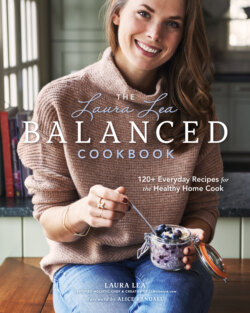Читать книгу The Laura Lea Balanced Cookbook - Laura Lea - Страница 52
На сайте Литреса книга снята с продажи.
Оглавлениеsmells. You can also put them down your
garbage disposal to make it smell fresh and
clean. Similarly, I like to keep one or two in my
refrigerator, which helps eliminate funky odors.
• Cooking with sea salt. When I refer to
salt throughout the book, I am referring
to fine-ground non-iodized sea salt. This
is the ideal all-purpose salt for cooking,
baking, and seasoning, in my opinion. I
prefer sea salt over traditional table salt.
Sea salt retains beneficial trace minerals, as
it is less processed, and table salt contains
anticlumping preservatives. You cannot
substitute one for the other, because table
salt is much more finely ground and the
same amount will yield a much saltier
result. Table salt also often includes iodine,
a crucial mineral, but one that we can get
from eating wild saltwater fish and seafood.
I prefer to control my intake of nutrients,
and this is difficult to do if they’re in the
salt you use every day. My favorite brands
are Selina Naturally and Frontier Natural
Products Co-op. If you want to indulge in
some lovely finishing salts, my favorites
are sea salt flakes and pink Himalayan sea
salt. Finishing salt is unrefined, natural
salt, usually with a slightly larger grain,
that is sprinkled on a dish before serving
to enhance the flavor.
FREEZING LEFTOVERS
When you’re trying to get healthy, whole-foods
meals on the table every night, the freezer can
become your best friend. That is, if you know what
to do with it. Here are my tested tips and tricks for
using your freezer to your advantage, as well as
some ideas for how to get creative with leftovers.
• Always ensure that your freezer is set at 0° F.
• Freeze fruit, vegetables, and soups in zip-
top storage bags in a thin layer and place
horizontally in the freezer. This way, you can
stack multiple bags, as well as easily break
off pieces to use. I suggest double-layering
the bags to prevent freezer burn if you plan
to keep them in there longer than a week.
• You can also use silicone muffin trays or ice
cube trays to freeze sauces. When frozen,
pop out the chunks and store in a zip-top
food storage bag.
• For quick meals, freeze individual portion
sizes in plastic pint containers that you can
order in bulk online.
• If you plan for an item to be in the freezer longer
than a week, double-bag it or wrap it with plastic
wrap before putting it in a container.
• LABEL all of your freezer bags and
containers: what and when. You need to
know how long something has been in there.
Also make some sort of symbol that denotes
if a food is about to go bad, and that’s why
you froze it. If you take it out to thaw, you’ll
know you need to eat it ASAP.
• Keep a notepad or whiteboard in your kitchen
that lists everything you have in your freezer
so you don’t have to go rummaging around
when deciding what to make for dinner.
• Invest in an insulated food and beverage
container. They’re an amazing tool for on-
the-go lunches, keeping food either hot or
cold. I like Thermos Foogo or FUNtainer
food jars and LunchBots.
